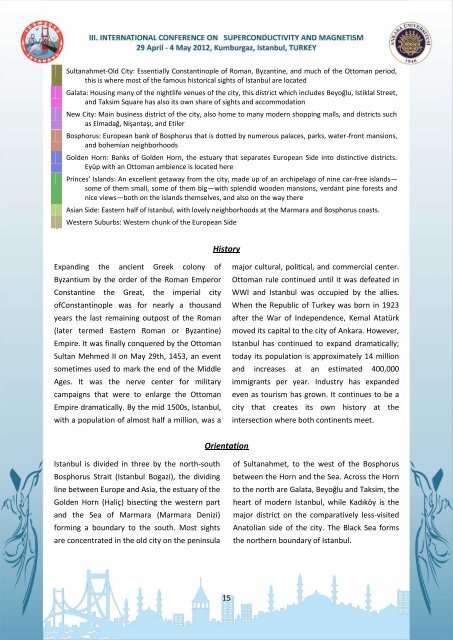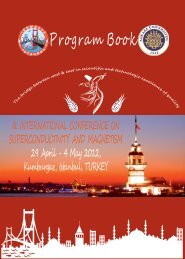practical information booklet here. - ICSM 2012
practical information booklet here. - ICSM 2012
practical information booklet here. - ICSM 2012
You also want an ePaper? Increase the reach of your titles
YUMPU automatically turns print PDFs into web optimized ePapers that Google loves.
Sultanahmet-Old City: Essentially Constantinople of Roman, Byzantine, and much of the Ottoman period,<br />
this is w<strong>here</strong> most of the famous historical sights of Istanbul are located<br />
Galata: Housing many of the nightlife venues of the city, this district which includes Beyoğlu, Istiklal Street,<br />
and Taksim Square has also its own share of sights and accommodation<br />
New City: Main business district of the city, also home to many modern shopping malls, and districts such<br />
as Elmadağ, Nişantaşı, and Etiler<br />
Bosphorus: European bank of Bosphorus that is dotted by numerous palaces, parks, water-front mansions,<br />
and bohemian neighborhoods<br />
Golden Horn: Banks of Golden Horn, the estuary that separates European Side into distinctive districts.<br />
Eyüp with an Ottoman ambience is located <strong>here</strong><br />
Princes’ Islands: An excellent getaway from the city, made up of an archipelago of nine car-free islands—<br />
some of them small, some of them big—with splendid wooden mansions, verdant pine forests and<br />
nice views—both on the islands themselves, and also on the way t<strong>here</strong><br />
Asian Side: Eastern half of Istanbul, with lovely neighborhoods at the Marmara and Bosphorus coasts.<br />
Western Suburbs: Western chunk of the European Side<br />
Expanding the ancient Greek colony of<br />
Byzantium by the order of the Roman Emperor<br />
Constantine the Great, the imperial city<br />
ofConstantinople was for nearly a thousand<br />
years the last remaining outpost of the Roman<br />
(later termed Eastern Roman or Byzantine)<br />
Empire. It was finally conquered by the Ottoman<br />
Sultan Mehmed II on May 29th, 1453, an event<br />
sometimes used to mark the end of the Middle<br />
Ages. It was the nerve center for military<br />
campaigns that were to enlarge the Ottoman<br />
Empire dramatically. By the mid 1500s, Istanbul,<br />
with a population of almost half a million, was a<br />
Istanbul is divided in three by the north-south<br />
Bosphorus Strait (Istanbul Bogazi), the dividing<br />
line between Europe and Asia, the estuary of the<br />
Golden Horn (Haliç) bisecting the western part<br />
and the Sea of Marmara (Marmara Denizi)<br />
forming a boundary to the south. Most sights<br />
are concentrated in the old city on the peninsula<br />
History<br />
Orientation<br />
15<br />
major cultural, political, and commercial center.<br />
Ottoman rule continued until it was defeated in<br />
WWI and Istanbul was occupied by the allies.<br />
When the Republic of Turkey was born in 1923<br />
after the War of Independence, Kemal Atatürk<br />
moved its capital to the city of Ankara. However,<br />
Istanbul has continued to expand dramatically;<br />
today its population is approximately 14 million<br />
and increases at an estimated 400,000<br />
immigrants per year. Industry has expanded<br />
even as tourism has grown. It continues to be a<br />
city that creates its own history at the<br />
intersection w<strong>here</strong> both continents meet.<br />
of Sultanahmet, to the west of the Bosphorus<br />
between the Horn and the Sea. Across the Horn<br />
to the north are Galata, Beyoğlu and Taksim, the<br />
heart of modern Istanbul, while Kadıköy is the<br />
major district on the comparatively less-visited<br />
Anatolian side of the city. The Black Sea forms<br />
the northern boundary of Istanbul.




